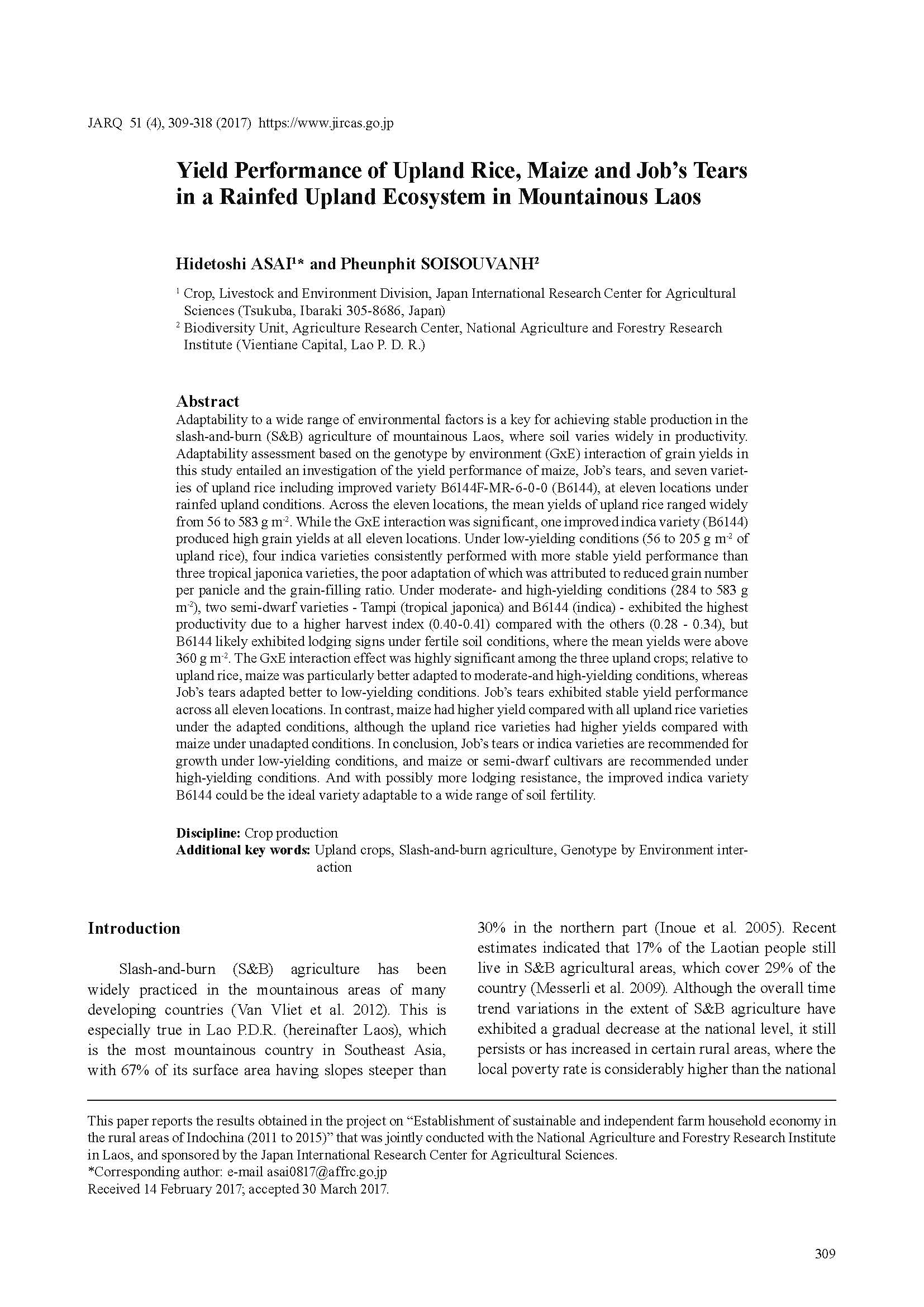Yield Performance of Upland Rice, Maize and Job’s Tears in a Rainfed Upland Ecosystem in Mountainous Laos
| ISSN | 00213551 |
|---|---|
| NII recode ID (NCID) | AA0068709X |

Adaptability to a wide range of environmental factors is a key for achieving stable production in the slash-and-burn (S&B) agriculture of mountainous Laos, where soil varies widely in productivity. Adaptability assessment based on the genotype by environment (GxE) interaction of grain yields in this study entailed an investigation of the yield performance of maize, Job’s tears, and seven varieties of upland rice including improved variety B6144F-MR-6-0-0 (B6144), at eleven locations under rainfed upland conditions. Across the eleven locations, the mean yields of upland rice ranged widely from 56 to 583 g m-2. While the GxE interaction was significant, one improved indica variety (B6144) produced high grain yields at all eleven locations. Under low-yielding conditions (56 to 205 g m-2 of upland rice), four indica varieties consistently performed with more stable yield performance than three tropical japonica varieties, the poor adaptation of which was attributed to reduced grain number per panicle and the grain-filling ratio. Under moderate- and high-yielding conditions (284 to 583 g m-2), two semi-dwarf varieties - Tampi (tropical japonica) and B6144 (indica) - exhibited the highest productivity due to a higher harvest index (0.40-0.41) compared with the others (0.28 - 0.34), but B6144 likely exhibited lodging signs under fertile soil conditions, where the mean yields were above 360 g m-2. The GxE interaction effect was highly significant among the three upland crops; relative to upland rice, maize was particularly better adapted to moderate-and high-yielding conditions, whereas Job’s tears adapted better to low-yielding conditions. Job’s tears exhibited stable yield performance across all eleven locations. In contrast, maize had higher yield compared with all upland rice varieties under the adapted conditions, although the upland rice varieties had higher yields compared with maize under unadapted conditions. In conclusion, Job’s tears or indica varieties are recommended for growth under low-yielding conditions, and maize or semi-dwarf cultivars are recommended under high-yielding conditions. And with possibly more lodging resistance, the improved indica variety B6144 could be the ideal variety adaptable to a wide range of soil fertility.
| Date of issued | |
|---|---|
| Creator | Hidetoshi ASAI Pheunphit SOISOUVANH |
| Subject |
Upland crops Slash-and-burn agriculture Genotype by Environment interaction |
| Publisher | Japan International Research Center for Agricultural Sciences |
| Available Online | |
| NII resource type vocabulary | Journal Article |
| Volume | 51 |
| Issue | 4 |
| spage | 309 |
| epage | 318 |
| DOI | 10.6090/jarq.51.309 |
| Rights | Japan International Research Center for Agricultural Sciences |
| Relation | : J-STAGE |
| Language | eng |
